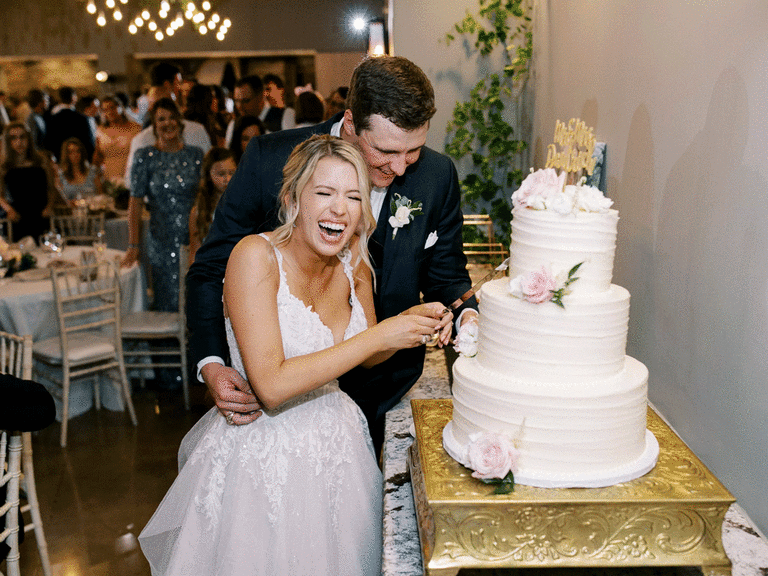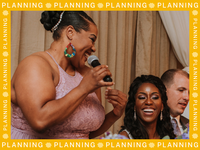Everything You Need to Know About Cutting the Wedding Cake
The wedding cake has long been a symbolic detail—the tradition of breaking the cake (or, at the time, bread) over the bride's head dates back to the ancient Romans. Customs evolve with the times, of course, and today the ceremonial cutting of the wedding cake has remained a popular and meaningful wedding reception activity. According to The Knot 2021 Real Weddings Study, 77% of couples had a cake-cutting ceremony during their reception. Many couples love this tradition because it provides a fabulous photo opportunity and symbolizes their first joint task as newlyweds. If you want to know about the history behind this wedding tradition, how to cut a wedding cake and much more, read all about it below.
The History of Cutting the Wedding Cake
This wedding cake tradition originates in the Victorian era when it was customary for the bride to cut the wedding cake, also known as the bride's cake. After cutting the cake, the bride was tasked with handing out the pieces, which represented fertility, to all her guests. Gradually, wedding guest lists grew, which required the groom to help with the cake-cutting ceremony. Now, one partner places their hand over the other's while cutting the first slice of cake as a symbol of their promise to support each other and to reflect the first responsibility they complete as a married couple.
When to Start the Cake-Cutting Ceremony
Usually, the cake cutting happens after dinner, so we recommend you do it between dinner and the parent dances. Cutting the cake lets guests know that the reception is almost over and that they can start heading home. For convenience, some couples like to have their couple-centered wedding tasks, like the bouquet toss and the wedding cake cutting, back to back. This helps out your catering team because they'll have more time to cut, plate and serve the cake for the guests. Feel free to personalize your reception timeline and cut the cake whenever it works best for you and your partner.
Our tip: Try to schedule the cake-cutting ceremony earlier in the reception. That way, if families with young children and elderly guests want to leave early, they can do so. Also, if you've opted for a wedding photography package where the price increases for additional hours of coverage after the baseline time, you can save money because the wedding photographer can leave earlier.
How to Cut a Wedding Cake
Even if you think you're a pro at cutting sweets—whether at birthday parties or other in-home entertaining—ask your cake baker or caterer for instructions before making the first cut. You wouldn't want to place the knife in the wrong spot and cause the delicate tower to topple over.
-
We recommend a wedding cake knife set for your first slice so you can make a quick and clean cut. (Bonus: A knife set is a great wedding keepsake you can cherish for years to come.) If you don't have one, use a large professional-grade knife from your venue or caterer.
FOR YOU19 Meaningful Vietnamese Wedding Traditions to UseShow respect for these customs by learning more about them.The Wedding Ceremony Processional Order, ExplainedWe've got expert-approved answers for different cultures and religions.Nail Your Ring Exchange Wording: Examples to UsePledge your love and put a ring on it. -
With your spouse, position yourselves so one of you is standing closest to the cake and holding the knife with your dominant hand while the other stands behind, placing their hand on top.
Using the knife, cut an inch into the bottom tier of the cake. Try to avoid making a sawing motion because it will cause the cake to crumble. By cutting at the bottom tier, you'll have more stability and it's easier to save the top tier of the cake to eat for your first anniversary if you'd like.
If you want a square-shaped piece, make another slice parallel to the first one you made about one to two inches over. If you want a wedge-shaped piece, make two diagonal cuts into the cake. How big or small you want your piece is up to you—just remember that you want at least two bites worth of cake for you and your partner.
-
Finally, slide your server under the piece of cake and gently place it on a plate.
Once the initial piece is cut, the newlyweds usually feed each other the first slice, symbolizing their commitment to providing for one another. In some cases, this moment is replaced by a different tradition: smashing cake into each other's faces. How you feed each other the cake is up to you, but remember, you don't need to smear frosting on your new spouse simply because you think your guests expect it. It's perfectly okay if you don't want to mess up your professional hair and makeup or run the risk of staining a pricey outfit. Have a chat with your spouse before the wedding to agree on a game plan—cake smash or not. Either way, ask your wedding planner or caterer to have napkins (or even better, a warm, damp cloth) nearby to wipe up any rogue crumbs and frosting quickly.
Serving Wedding Cake To Your Guests
Once you've done the wedding cake cutting, the catering staff will take over and bring it back to the kitchen to slice for the rest of your guests. (Or cut a sheet cake version of your wedding cake, which is more common for larger parties.) If you're planning to save the top tier of the cake, let the catering staff know in advance.
In the past, couples actually sent their guests home with cake or sent pieces to those who were unable to attend. While this tradition isn't as common anymore—it's most often replaced by separate wedding favors—it's still a nice gesture (and a great way to avoid wasting cake) to offer boxed slices for guests at the end of the evening as a sweet takeaway.
























